Marquesas
Marquesas--The Remote Diving Experience
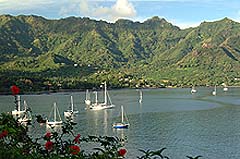 Nuku Hiva is the largest island in the Marquesas and second only to the island of Tahiti. Isolated nearly 1,000 miles out into the Pacific, the Marquesas are a group of islands with their own culture and history. With only 2,400 inhabitants, high mountains, long valleys and isolated bays, Nuku Hiva is one of French Polynesia's most remote adventures.
Nuku Hiva is the largest island in the Marquesas and second only to the island of Tahiti. Isolated nearly 1,000 miles out into the Pacific, the Marquesas are a group of islands with their own culture and history. With only 2,400 inhabitants, high mountains, long valleys and isolated bays, Nuku Hiva is one of French Polynesia's most remote adventures.
The airport is located on the north west corner of the island where land is flat and the winds are favorable. This makes a long and bumpy 4-wheel drive but well worth it as the countryside is very scenic. About halfway, in the large central valley, is an organic farm and dairy. Organic ice cream can be sampled there or at the hotels who make their own version. You can also take the 7 minute helicopter ride but we reserved that for the ride out when we hoped to persuade the pilot to fly past the 1000-foot Hakaui waterfall.
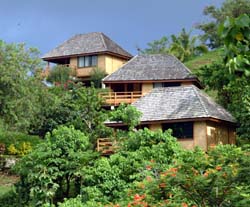 Be prepared for a long first day as the flight from Papeete may stop in Rangiroa (Saturdays only) and the two-hour four-wheel drive from the airport (depending on photo stops) arrives at the Pearl Beach Lodge too late for diving. You can select to take the seven-minute helicopter ride (except Saturdays) but it may be too expensive considering the initial cost and any extra charges for excess weight. The long and bumpy ride through the island's interior is fun and interesting and is best done on the first day.
Be prepared for a long first day as the flight from Papeete may stop in Rangiroa (Saturdays only) and the two-hour four-wheel drive from the airport (depending on photo stops) arrives at the Pearl Beach Lodge too late for diving. You can select to take the seven-minute helicopter ride (except Saturdays) but it may be too expensive considering the initial cost and any extra charges for excess weight. The long and bumpy ride through the island's interior is fun and interesting and is best done on the first day.
Once you are settled in, you quickly realized that you have arrived in paradise. From the balcony of the Nuku Hiva Keikahanui Pearl Lodge, the bay below shimmers with a beauty unmatched in French Polynesia. The Pearl overlooks the bay and village of Taiohae with a nearly-black sand beach below. The 20 bungalows sit upon a hill with panoramic views of the bay and village. Local artwork adorns each bungalow with all the comforts afforded by the best hotels.
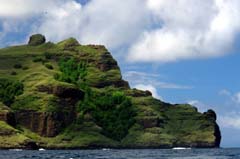 The Centre De Plongee Marquises, operated by Xavier Curvat, dives along more than 60 miles (100 kms) of rugged basalt coast. There are sheer walls and a large number of caves to explore. although visibility at times is poor, it can reach 60 feet. Big pelagic fauna are abundant, including eagle rays, stringrays, barracudas, manta rays and hammerhead sharks.
The Centre De Plongee Marquises, operated by Xavier Curvat, dives along more than 60 miles (100 kms) of rugged basalt coast. There are sheer walls and a large number of caves to explore. although visibility at times is poor, it can reach 60 feet. Big pelagic fauna are abundant, including eagle rays, stringrays, barracudas, manta rays and hammerhead sharks.
Small groups of divers can reach dive sites to the west and to the east with rides not exceeding one hour in each direction. Many excellent sites are available within a few minutes and depending on the weather and the size of the swell, 15 different sites are routinely possible.
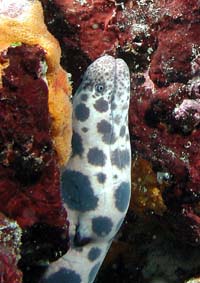
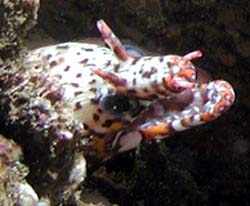 There are 15 different types of moray eels including the dragon moray found only in the Marquesas. Friendly octopi are also found in the crevices. Several kinds of lionfish are present.
There are 15 different types of moray eels including the dragon moray found only in the Marquesas. Friendly octopi are also found in the crevices. Several kinds of lionfish are present.
Hammerhead Guard Rock is a favorite site only ten minutes from the dive shop. Frederic, our French divemaster, explains that pounding two rocks together will attract hammerhead sharks but rapid breathing will chase them away. There are no guarantees and after three different dive attempts we still had not seen a single hammerhead. In fact, I expected large numbers of many different sharks to be present around the Marquesean island as it is located far out into the Pacific. But few sharks were seen.
 Cave diving is very interesting with giant lobsters, groups of stingrays and pockets of freshwater or air to explore. Ekamako Cave, 15 minutes from the dive shop, has a wide mouth, 20 or more stingrays and too many lobsters to count.
Cave diving is very interesting with giant lobsters, groups of stingrays and pockets of freshwater or air to explore. Ekamako Cave, 15 minutes from the dive shop, has a wide mouth, 20 or more stingrays and too many lobsters to count.
Along the east coast, only accessible when the seas are flat, is home to a school of several hundred melon-headed whales (closely related to the pygmyee orcas). The plan was to view them only by snorkel as they do not fancy bubbles.
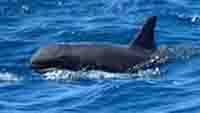 These friendly Pepanocepha electra frolicked as Lynn, my dive buddy, assistant writer and artist, captured memories for future paintings. November to April is a good time to swim with these beautiful creatures and we decided to return another year to collect some underwater video footage.
These friendly Pepanocepha electra frolicked as Lynn, my dive buddy, assistant writer and artist, captured memories for future paintings. November to April is a good time to swim with these beautiful creatures and we decided to return another year to collect some underwater video footage.
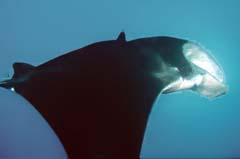 As the weather improved, we planned a journey to the west side of the island to search for manta rays and hammerhead sharks. Matateteiko Point has a shallow swim-through cave near its tip where we entered to approach the dive site. On the other side of the cave we saw a small stingray and then in the distance, a manta ray approached. The excitement of the group increased as three more mantas joined the first to circle and play with the divers. All four were small Black Mantas with many small spots on their white ventral surface. After twenty minutes or more we were out of air and had to conclude our manta fun.
As the weather improved, we planned a journey to the west side of the island to search for manta rays and hammerhead sharks. Matateteiko Point has a shallow swim-through cave near its tip where we entered to approach the dive site. On the other side of the cave we saw a small stingray and then in the distance, a manta ray approached. The excitement of the group increased as three more mantas joined the first to circle and play with the divers. All four were small Black Mantas with many small spots on their white ventral surface. After twenty minutes or more we were out of air and had to conclude our manta fun.
Our very next dive we went around the point but were unimpressed as the visibility was very bad. Returning to the surface for our rest stop and with little reserve air the water became clear. All of a sudden we were approached by a school of eight hammerhead sharks. By then I was buddy-breathing with Lynn and almost out of digital frames. The excitement overtook me and I was unable to capture a single image in the 15 second encounter. What I would have given for my video camera at that moment! However, Lynn had to back-paddle as a large hammerhead approached. She did not need a camera to capture the moment.
 On our last day we journeyed into Ekamako Cave. It is a large cave with two chambers. Lobster are plentiful as well as sting rays. In the darkness of the first chamber, stingrays, sometimes numbering twenty or more, settle on the sandy bottom and are quite approachable. There was also a vertical tube filled with fresh water to taste. In the second chamber, an air pocket was large enough to allow eight dives to surface and breath the warm mist. As we finished our cave dive, we returned to the wide mouth and rested upon the sandy bottom to meditate on the underwater existence as light from the outside ocean streamed in past fish held motionless in the ocean's surge.
On our last day we journeyed into Ekamako Cave. It is a large cave with two chambers. Lobster are plentiful as well as sting rays. In the darkness of the first chamber, stingrays, sometimes numbering twenty or more, settle on the sandy bottom and are quite approachable. There was also a vertical tube filled with fresh water to taste. In the second chamber, an air pocket was large enough to allow eight dives to surface and breath the warm mist. As we finished our cave dive, we returned to the wide mouth and rested upon the sandy bottom to meditate on the underwater existence as light from the outside ocean streamed in past fish held motionless in the ocean's surge.
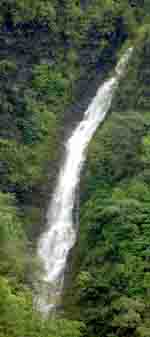 In addition to diving, Nuhu Hiva affords many opportunities for land and cultural experiences. The all day four-wheel drive excursion to Anaho on the north side of the island passes waterfalls and sweeping vistas. The beach at Anaho is not to be missed as the towering rocks overhead creates a lost sense of primitive existence. Lobster at the local restaurant and a visit to one of the important archeological sites completes the day. Other excursions are available such as a two-hour hike to one of the world's largest waterfalls near Hakaui. Boat and horse trips reach areas not possible even by 4-wheel drive vehicles.
In addition to diving, Nuhu Hiva affords many opportunities for land and cultural experiences. The all day four-wheel drive excursion to Anaho on the north side of the island passes waterfalls and sweeping vistas. The beach at Anaho is not to be missed as the towering rocks overhead creates a lost sense of primitive existence. Lobster at the local restaurant and a visit to one of the important archeological sites completes the day. Other excursions are available such as a two-hour hike to one of the world's largest waterfalls near Hakaui. Boat and horse trips reach areas not possible even by 4-wheel drive vehicles.
Marquesians have many gods; the turtle is for the sea and the lizard for the land. Turtles are fertility symbols and are depicted as part of many Tikis. One on the oldest Tikis is located at the archeological site near Anaho. The sea turtle rests on top of the embrace of the king and queen.
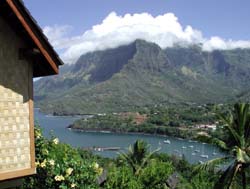 Plan to visit Hiva Oa, which can be connected on your return, for a very small additional fee. However, you must be content with the many land excursions as there are no diving facilities on this or any other island other than Nuku Hiva. The beautiful Hiva Oa Hanakee Pearl Lodge faces Mount Temetiu (3903 feet) with views of Bordelais canal and harbor, the small village of Hanakee and the volcanic island of Tahuata in the center of Traitors Bay. Each of the 20 bungalows (identical to Nuku Hiva) were decorated individually with local artwork and have spectacular panoramas.
Plan to visit Hiva Oa, which can be connected on your return, for a very small additional fee. However, you must be content with the many land excursions as there are no diving facilities on this or any other island other than Nuku Hiva. The beautiful Hiva Oa Hanakee Pearl Lodge faces Mount Temetiu (3903 feet) with views of Bordelais canal and harbor, the small village of Hanakee and the volcanic island of Tahuata in the center of Traitors Bay. Each of the 20 bungalows (identical to Nuku Hiva) were decorated individually with local artwork and have spectacular panoramas.
 Diving the remote cliffs of Nuku Hiva brings many rewards both above and below the waterline. Diving highlights include several endemic species including the dragon eel and white spineless sea urchins. Peponcephala electra, eagle rays, mantas and hammerhead sharks round out the experience. It is the lush jungles, shimmering bays, warm people and intact culture that make the Marquesas a destination not to be missed.
Diving the remote cliffs of Nuku Hiva brings many rewards both above and below the waterline. Diving highlights include several endemic species including the dragon eel and white spineless sea urchins. Peponcephala electra, eagle rays, mantas and hammerhead sharks round out the experience. It is the lush jungles, shimmering bays, warm people and intact culture that make the Marquesas a destination not to be missed.
